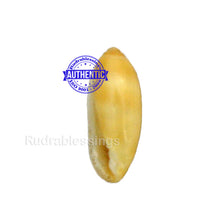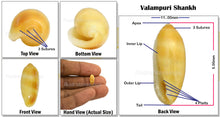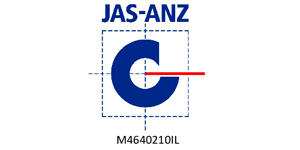Name: Valampuri Shankha (right handed)
Locality: Indian Ocean
Measurement: Length: 11.00 mm approx. Breadth: 5.00 mm approx.
Weight: 0.11 gms.
Opening towards: Right hand
Sutures (Circle on the conch): 3, Sutures are angular.
Plates (Vertical ridges in the conch cavity): 4
Quality: Genuine.
X-Ray of the shell proving its authenticity is provided.
Product Description
Valampuri Shankha
Dear readers and potential clients, the article may be a little long but if you read this you could almost call yourself an expert on valampuri shankhs, there are lot of facts, proofs and unanswered questions that are cleared here.
What is a Dakshinavarty valampuri shankh ?
It is very important to know everything about the product you wish to buy, so before buying a dakshinavrty valampuri shankh, you should know the types, importance & authenticity of the same.
As per Indians the word "Dakshinavarty" means "south", "VALAM" means "RIGHT" "PURI" means "HANDED"; so the entire word means the right handed shell coming from the south of India. To elaborate if you see images of Lord vishnu he carried a shell which opens towards the right in his hand.
It’s a phenomena of nature that most shells produced usually open towards the left, it is 1 in a million a shell opens towards the right and hence it is rare, it’s like there would be one white tiger in a few hundreds of regular skin colored tigers.
Further there are two to nine raised lines which appear from the opening of the shell and coils up to the internal body right up to the head of the shell; these lines are called pillae in technical language. So to summarize a Valampuri Shankh is the one which opens to the right with two to nine pillae that appears from the opening and coils up right to the head of the shell. There could be many shells that opens to the right but do not have any pillae, they are not rare. The one’s without any pillae are of not much significance / Mythological Significance
Geographic location & associations
The term dakshinavarty valampuri shankh is a term used by south indians in their local language, they are referring to the shell that opens towards the right side from the seas of South India. Now this is where a lot of secrets and answers to many questions are hidden. If we go back 100s and 1000s of years in the era of Lord rama, Lord krishna and other prior incarnations of Lord Vishnu, at that time the sea to the south of india would be infinite stretching from probably today what we call goa on south west to chennai, vizag on south east to kerela & rameshwaram in south, now it just doesn’t stop here the sea to the south of india would go infinitely to Srilanka, Indonesia, Singapore, Andaman, Lakshwadweep, Mauritius, Maldives and probably beyond. We are talking about an era where these countries wouldn’t have been in existence and it was simply called as south (dakshin) (know by a direction or their dynasties but not by name of a country). So here is my question why are traders of south india simply restricting the right handed shankh in hands of lord vishnu to the shankh that comes out simply only in their region in India. Is it mentioned in the shastras that this shell would only come from seas of Chennai, Kerela, or any south india region itself?, these countries beyond india in the south itself might have got their names in the recent years, most of them would be dynasties or tribal lands.
In shastras it is simply mentioned that the shell in hands of lord vishnu is right hand that opens to the right and has some pillae running from the opening to the head of the shell. Now this could be produced anywhere in the seas in different pockets. Further there may have been lot of changes geographically due to earthquakes, tsunamis, storms, tidal waves or cyclones and due to that evolutions in form of size, colour, and pattern of the shells with geographical location have changed in so many years. The only motive of South Indian Conch traders is to prove that the shankh which they procure and offer are valampuri shankh and further claim that shankh brought from south Indian traders are genuine and shankh offer from India or any other country are non genuine. As if they want to say that they themselves are going under the sea and taking the shell out which is unbelievable. We do not claim that south Indian seller are selling non genuine shells, we are only saying that shells can come from different areas geographically not necessary only south india, due to high demand prices remains high since the availability is limited in these areas, now if we slightly go beyond this areas, where the commercial value of the shell is not that high in comparison to that of so called south india, we get a chance to possess this equally rare and valuable shell which is one of the accessories of The great lord vishnu
Price & analogy
The shell coming from south of india is priced at around a whopping 10000/ per gram to 15000/per gram, yes 5 times the price of gold, making the shell price more than 7.5 lakhs indian rupees even if its small piece of 50 grams in weight. sizes smaller than that are sold per piece on not by weight, but would cost above 7.5 lakhs
This is only because end users have not applied logic and strictly restricted to the shell produced by mother nature in limited locations of south india leading to phenomenal rise in its prices, as we go beyond this small area of sea we see the shells opening towards the right produced very scarcely as well but not priced that high. We have restricted the presence of lord vishnu only to the south of india which is not logical, as even today there are more 1000 year old temples in Indonesia, thailand, we have seen remains of buddhist temples in iraq which then was called as audrapur. the division of countries or it getting its new names has not been a very old process and not very ancient and thus a person needs to realise this. Rudrakshas produced in Nepal are most expensive but that doesn’t mean rudrakshas produced in Indonesia, india or the usa are not rudrakshas, the commercial value may be less but no one can challenge its auspiciousness as it belongs to the same Lord Shiva.
Some analogy to give you an insight on what we trying to say
The Siberian tiger has fur and the indian tiger doesn’t, it doesn’t mean either of them are not tigers, due to location at times there are variations dues to adaptability.
Basmati rice is considered to be the best in india, that doesn’t mean other varieties of rice are not rice, yes there would be a difference in quality and hence its price but ultimately rice is rice.
The shankh noticed in hands of Lord vishnu opens towards the right and has visible spirals from the opening coiling right upto the conch head, but is nowhere written on the conch shell that is produced only in Chennai or Rameshwaram.
As the price keeps going higher the human psychology gets more attracted to it. Having said that i don't run away from the fact that low price items are always genuine. this takes our explanation of the (click here) authenticity of the shell.
We do not have any arguments with our competitors. They are free to contradict the same but we like to remain on our own thoughts.
Hereby we have taken an effort to offer you the great right handed shell produced in different regions at a very lower price with equivalent auspiciousness. Each and every shell comes with an X ray, showing that its one piece and not artificially joined. Also it shows the pillae (lines which appear from the opening of the shell and coils up to the internal body right up to the head of the shell)











